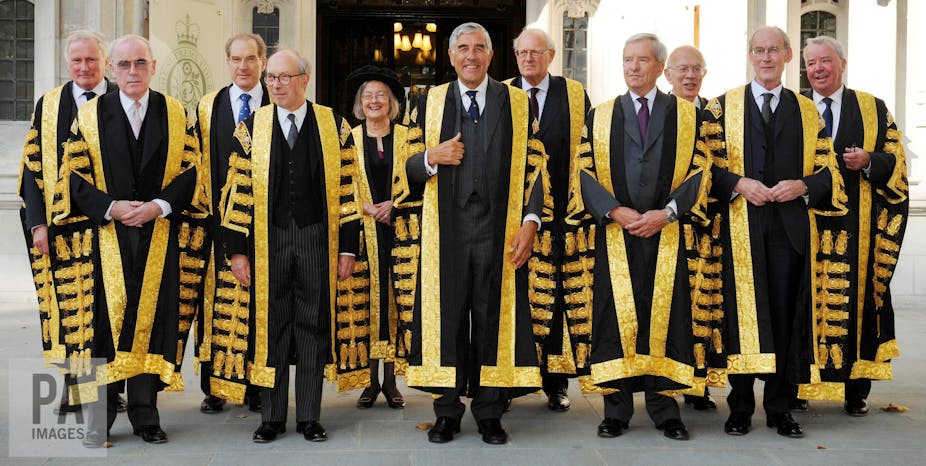The UK judiciary has a long history of fairness, integrity and soundness of judgement – but not diversity.
In theory, the balance of judges’ ethnicity, gender and background should reflect society. Although there have been moves to improve diversity in the profession, the vast majority are still white, middle-class, private-schooled, Oxbridge-educated men.
However, a rare opportunity for change has arisen in the Supreme Court.
Established in 2009, the Supreme Court is the final court of appeal in the UK. As the highest court, it considers final appeals on both civil and criminal issues referred to it. The rulings, typically heard by five judges, not only finalise the case at hand but also help shape the country’s laws going forward. Judges are given life tenure when appointed to the Supreme Court, and usually retire at 70 years old.
In 2016, Lord Toulson retired from the Supreme Court. Lord Neuberger, Supreme Court president, also announced that both he and Lord Clarke will retire in 2017. In addition, Lords Mance, Hughes and Sumption will all reach retirement age in 2018. In the space of two years, at least half of the Supreme Court Justices will need replacing.
Few would now dispute the importance of a diverse judiciary – but the question is should the Supreme Court now be trying to accelerate developments?
Diversity matters
The role of the judiciary is different to that of parliament or government: MPs who make the law represent society as elected officials. Judges, appointed on merit, are there to apply the law impartially. Personal characteristics should not matter, but in reality a mixture of backgrounds, ethnicities and genders are necessary to better equip the judiciary with the skills to adjudicate.

Of the 12 current Supreme Court justices, all are white, one is female, and only two were state schooled. None of them would be considered as having “disadvantaged backgrounds”.
If we accept that judicial talent is widely distributed among the population, then the under-representation of well-qualified women, black and minority ethnic (BAME), LGBT and disabled judges suggests that we are missing out on the best talent.
More widely across the judiciary, while there has been an increase in female and BAME numbers overall, progress has been marginal, and largely within the lower courts. Only one in 20 judges are non-white, and fewer than one in four are female. In the Court of Appeal, there is not one BAME judge, and only 4.5% within the High Court.
Positive discrimination
In the future, the judiciary should be able to draw upon applicants with more varied backgrounds. The historic elitism of the legal profession has changed: in 1964 there were only 2,500 barristers and 32,000 solicitors, compared to over 15,000 and 122,000 today.
Nevertheless commentators have argued we now need to proceed urgently with positive discrimination appointments, aiming for a minimum 40:60 gender ratio across the judiciary, similar to the European Court of Human Rights.
Former Lord Chancellor Jack Straw also believed that the best way to diversify was to have positive discrimination, suggesting that underrepresented groups could be supported by, for example, having all-women shortlists, in a similar way to the House of Commons. His successor, Liz Truss, has expressed similar views. However, this presumes that all genders and ethnicities are given equal opportunities to succeed before they become eligible for judicial appointment. The Judicial Appointments Commission – which Straw himself established – was also introduced for the very reason of limiting prejudice on the basis of the individual’s sex, ethnicity or background. On this basis, gender specific shortlists could be counter-intuitive.
Positive discrimination has been met with mixed reviews from current Supreme Court justices. Lord Sumption branded it patronising and called for an honest public debate. To him, introducing criteria other than merit would result in a bench with fewer outstanding judges, and could put off talented candidates from applying.
Nonetheless, Lord Neuberger and Lady Hale have stated that the Supreme Court must now “lead the way” in diversifying the judiciary, and should not simply rely on lower courts to make changes. Consequently they have announced proposals for half-day “insight sessions” where a wider variety of potential candidates are given the opportunity to sit in the Supreme Court with the current justices. Other suggestions include appointing someone part-time, and more widely advertising opportunities beyond just the Bar Council and Law Society.
Accelerating diversity
So what actually needs to change? Rather than looking at accelerating individuals to the Supreme Court earlier, it would be better to look at what mentoring and promotion opportunities exist for underrepresented groups to first progress to the High Court. This will allow these individuals to develop the qualities to be appointed based on merit alone, without the need for any positive discrimination or accelerated promotion strategies. But this would also need to extend beyond the legal profession, for example, into diversity of Oxbridge admissions.
One must also remember that matters which reach the Supreme Court relate to highly complex points of law. Their interpretations establish precedents for all lower courts to follow. Such responsibility should only fall on the most qualified and experienced.
However, when Lord Neuberger talks of the need to attract diverse candidates to the Supreme Court, he limits scope to draw upon those with senior judicial experience. The statistics show the legal profession is slowly changing. But it will take time for a more diverse group to reach the pinnacle of a distinguished legal career and have sufficient experience for Supreme Court appointment.
It is not that the Supreme Court shouldn’t be concerned with diversity, but rather that the current wider composition of the judiciary is not yet ready to service an accelerated recruitment objective.

